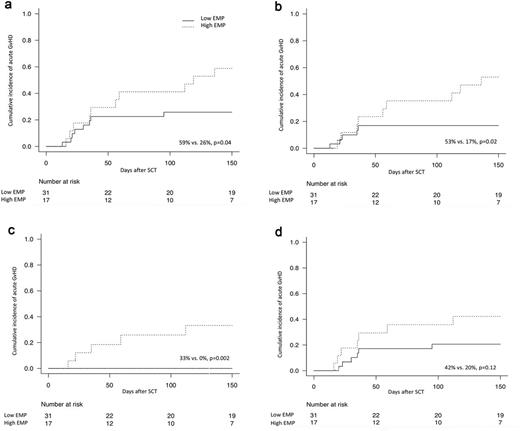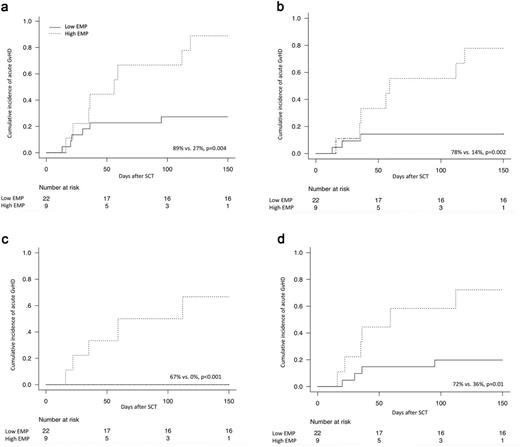Abstract
Background Graft-versus-host disease (GvHD) remains a leading cause of morbidity and mortality among allogeneic stem cell transplantation (SCT) patients. New research focusing on diagnostic methods and therapeutic interventions is required. Microparticles (MP) are structures ranging from 0.1 to 1 µm that are derived from the cell membranes of different cellular subtypes. The majority of circulating microparticles are derived from megakaryocytes (platelets) and erythrocytes. These structures have been described as biomarkers of cellular damage, activation, and intercellular signaling in in several autoimmune and vascular diseases. Whether the biologic events that characterize GvHD can alter the shedding of microparticles has not been described.
Methods Patients who underwent allogeneic stem cell transplantation between august 2012 and September 2014 at the Hospital Sirio Libanes (Sao Paulo, Brazil) were included. Adult and pediatric patients were consecutively enrolled if neutrophil engraftment was achieved. Circulating MP were isolated and quantified by flow citometry. Annexin V-positive (total microparticles - TMP), CD61+ platelet-derived microparticles (PMP) and CD235+ erythrocyte-derived microparticles (EMP) were measured at neutrophil engraftment.
Results MP were studied in the plasma of 48 patients. The levels of PMP were not associated with the risk of acute GvHD. However, the cumulative incidence (CI) of aGVHD was significantly increased among the patients with EMP counts above 360/µL at engraftment (59% vs. 26%, P=0.04). Higher EMP counts were associated with increased incidence of skin aGVHD (53% vs. 17%,P=0.02) and liver aGVHD (33% vs. 0%, P=0.002). There was no significant association between higher EMP count and incidence of gastrointestinal (GI) aGVHD (42% vs. 20%, P=0.10). The microparticles counts at engraftment were influenced by the intensity of the conditioning regimen. When compared with reduced intensity regimens, myeloablative regimens were associated with significantly higher EMP counts (152 vs. 349/µL, P=0.03). In patients exposed to reduced intensity conditioning regimens, a stronger association of a high EMP count and acute GvHD was observed (89% vs. 23%; p=0.002). A high EMP count was predictive of skin aGVHD (78% vs. 14%, P=0.002), liver aGVHD (67% vs. 0%, P<0.001), and GI aGVHD (72% vs. 20%, P=0.006).
Conclusion Our data suggest that higher counts of erythrocyte-derived microparticles at engraftment may be associated with a greater risk of acute GVHD.
Cumulative incidence of aGVhD II-IV (a), skin aGVhD (b), liver aGVhD (c) and GI aGVhD (d) in patients with high EMP count vs. low EMP count at engraftment.
Cumulative incidence of aGVhD II-IV (a), skin aGVhD (b), liver aGVhD (c) and GI aGVhD (d) in patients with high EMP count vs. low EMP count at engraftment.
Cumulative incidence of aGVhD (a), skin aGVhD (b), liver aGVhD (c) and GI aGVhD (d) In the subgroup of patients exposed to reduced intensity conditioning for patients with high EMP count vs. low EMP count at engraftment.
Cumulative incidence of aGVhD (a), skin aGVhD (b), liver aGVhD (c) and GI aGVhD (d) In the subgroup of patients exposed to reduced intensity conditioning for patients with high EMP count vs. low EMP count at engraftment.
No relevant conflicts of interest to declare.
Author notes
Asterisk with author names denotes non-ASH members.



